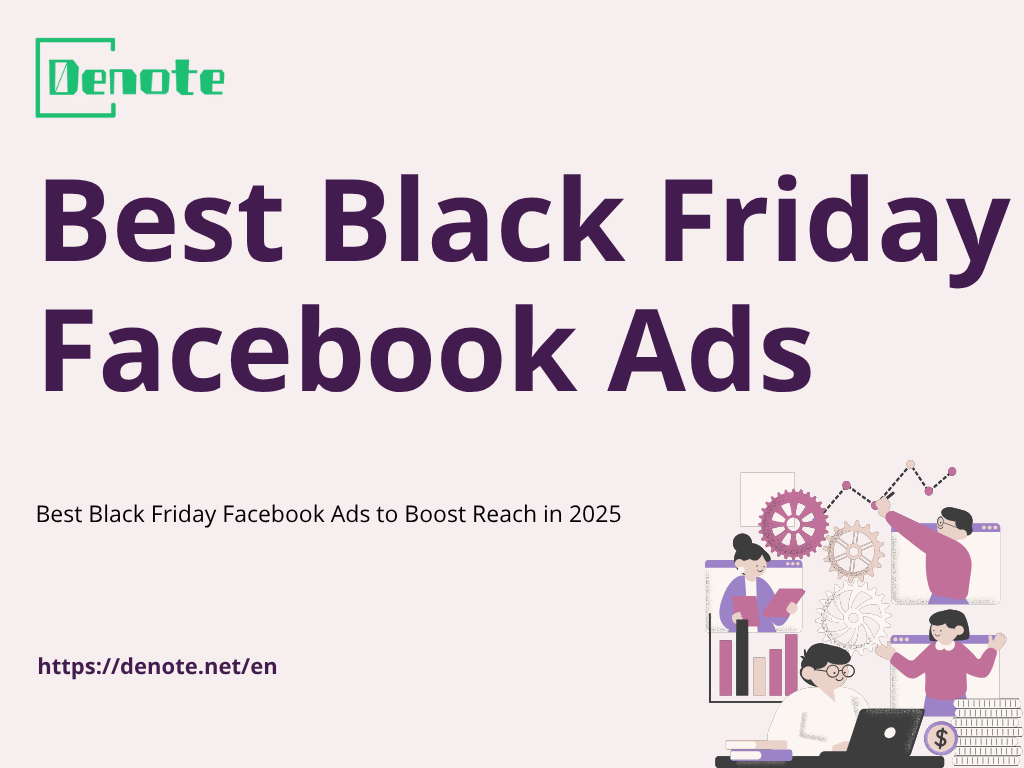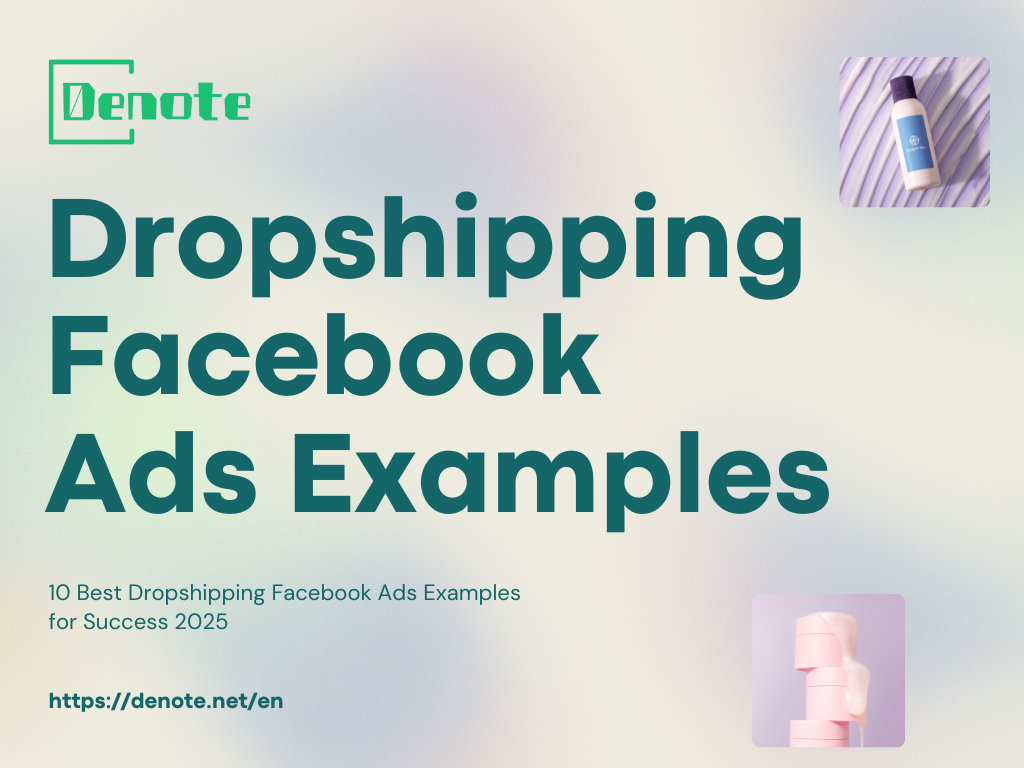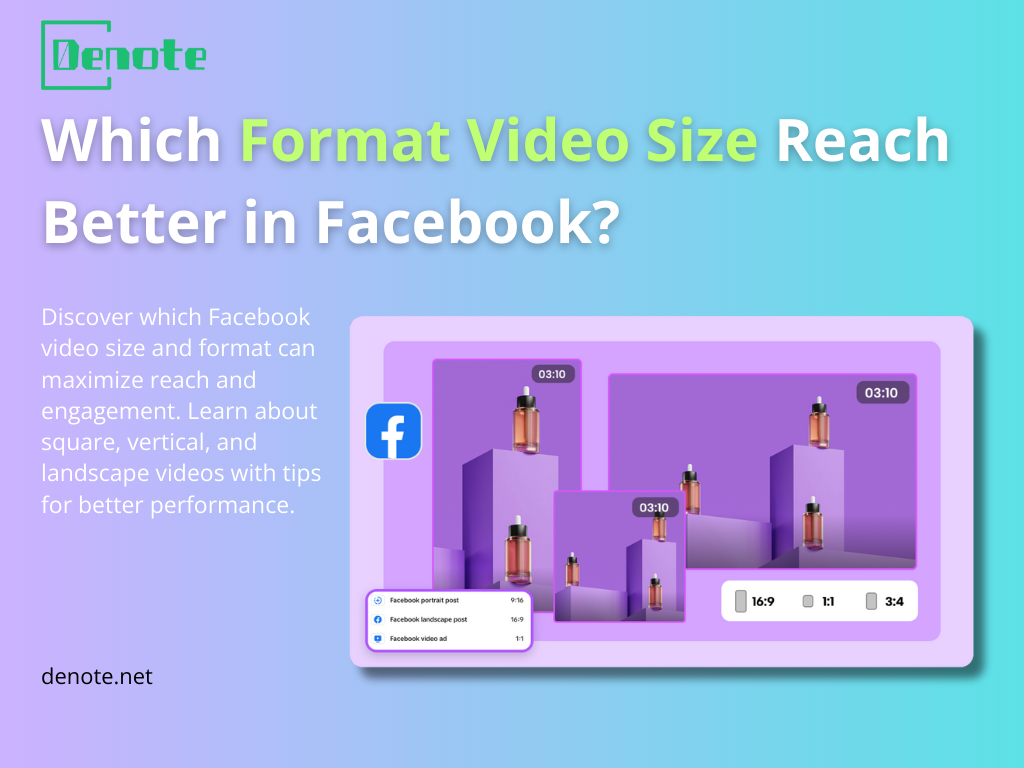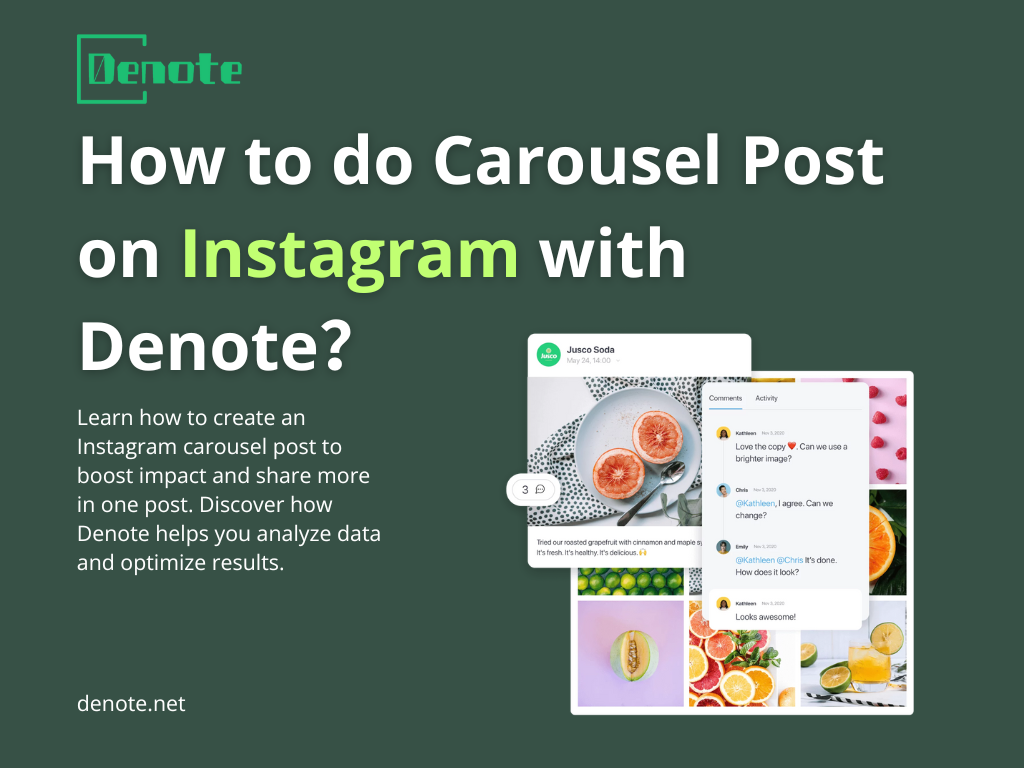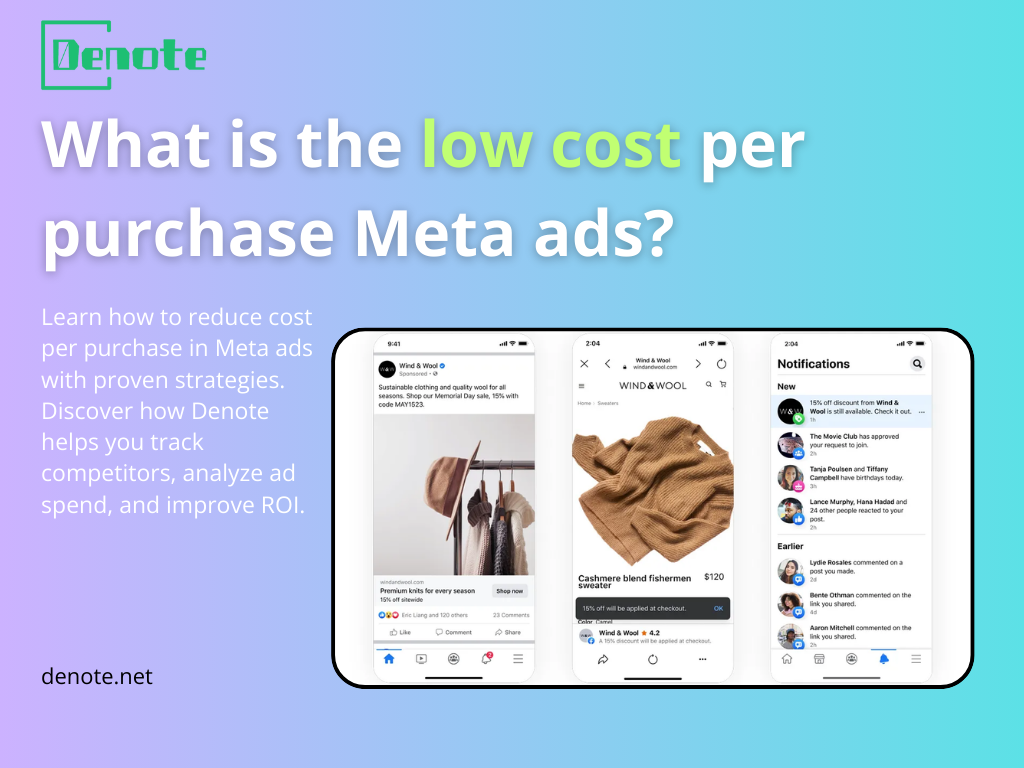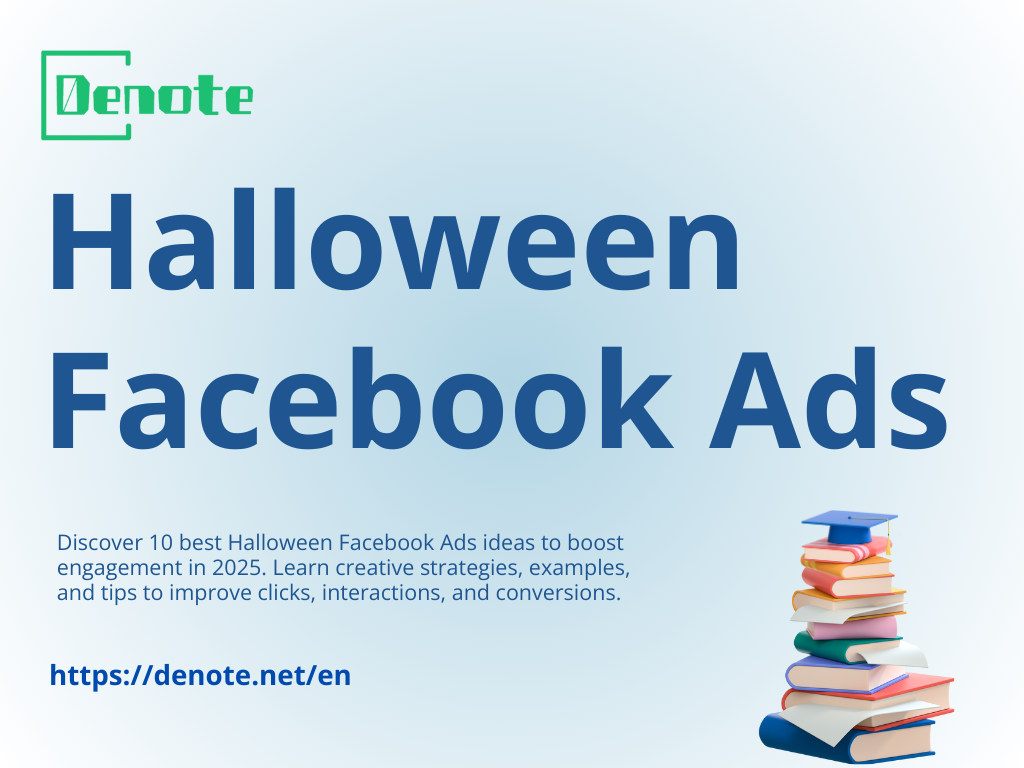How to Scale Facebook Ads for Maximum ROI in 2025
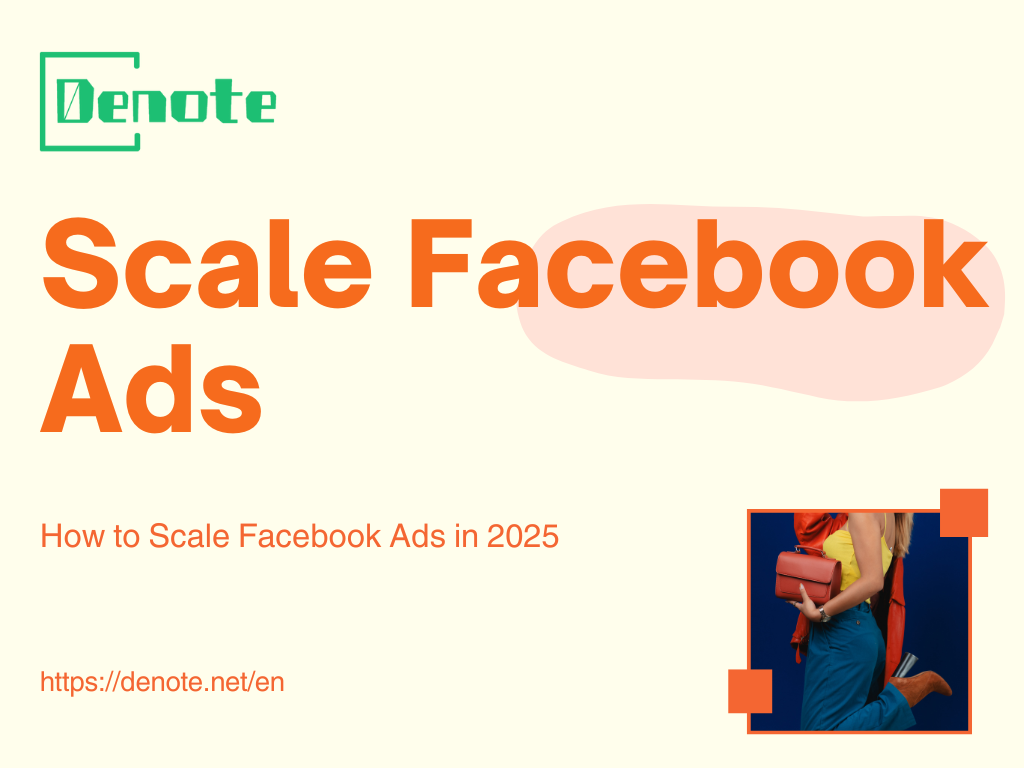
Why Scaling Facebook Ads Is Harder in 2025
Scaling Facebook ads in 2025 feels a bit like trying to speed up on a highway that keeps adding toll booths. Every mile gets more expensive and more complex. The platform is mature, auction dynamics are more competitive than ever, and marketers face an evolving mix of technical, behavioral, and regulatory challenges. If you want to scale Facebook ads successfully this year, you need realism up front: scaling is not a magic button — it’s an engineering problem with creative, data, and timing parts.
Three broad trends make scaling harder today: rising ad costs and competition, opaque algorithm shifts and longer learning phases, and user privacy and behavior changes. Each of these demands different remedies. Below I break down what’s actually happening and how to think about it before you pour more budget into a campaign.
Rising Ad Costs and Competition
Imagine every advertiser suddenly crowding into your favorite boutique — prices for the same jacket skyrocket. That’s the current state of Facebook’s ad auction. More brands (and automation tools) chase the same high-value audiences, driving up CPMs and making efficient scale harder. Niches that were cheap two years ago can now cost two or three times more.
What to do:
- Focus on narrower conversion events and consider lower-funnel audiences when scaling to control CPA creep.
- Prioritize creative differentiation: the same static image that worked last year won’t beat today’s competition.
- Use blended buying strategies (mix prospecting, mid-funnel, and retargeting) so you’re not bidding against yourself.
When you try to scale Facebook ads, small inefficiencies are magnified by volume — so tighten everything before you push more budget.
Algorithm Changes and Learning Phases
Facebook’s ad delivery system is a living beast. Every tweak to learning windows, attribution, or delivery optimization changes when and how your ads reach people. The learning phase can take longer now because of the way conversions are attributed and because audiences are more fragmented.
A couple of implications:
- Patience matters. If you spin up new ad sets and immediately double the budget, you’ll reset learning and may waste spend.
- Focus on consistent conversion signals — fewer, cleaner events help the algorithm learn faster.
- Keep experiments small and methodical. If you follow a haphazard trial-and-error approach, you’ll confuse both the algorithm and your reporting.
If you want to scale Facebook ads without flushing money down the drain, respect the learning curve and structure tests so the system gets clear signals to optimize from.
User Behavior and Privacy Shifts
Users are savvier and privacy-sensitive. Third-party data has been diluted, and people react less predictably to advertising. Changes in privacy policies and tracking (of which Apple’s ATT is the poster child) have made it harder to rely on old targeting tricks.
How to adapt:
- Invest in first-party data: email lists, on-site behavior, and product interactions become your secret sauce.
- Use creative that respects context and provides value — pushy messaging gets ignored or hidden more than ever.
- Embrace multi-touch attribution frameworks and incremental lift tests to understand true campaign impact.
Scaling Facebook ads in 2025 requires a privacy-first mindset: less stalking, more relationship-building.
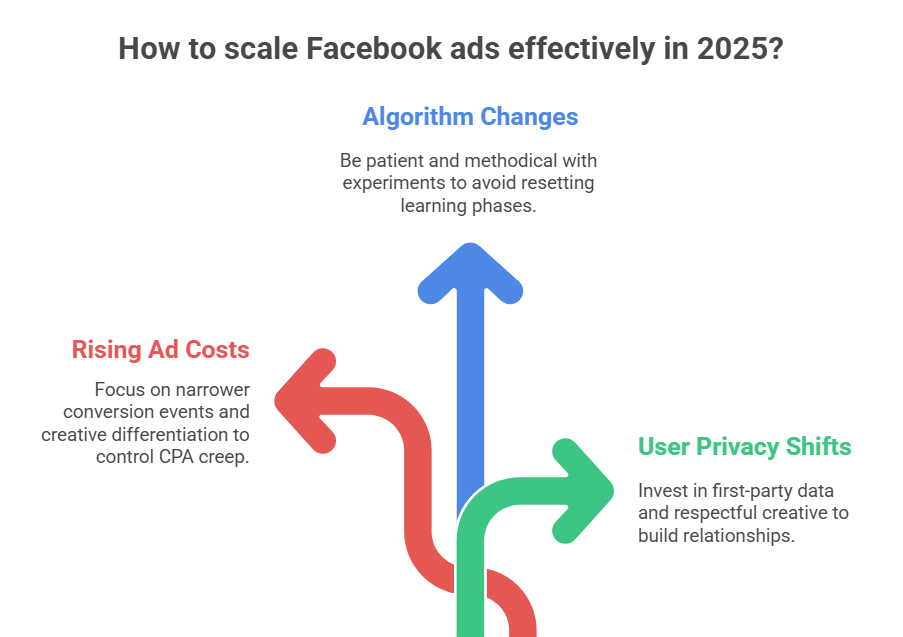
Foundation Before You Scale
Look, don’t go dousing your nonexistent engine in gas and expect magic. Gotta check if there’s even an engine under the hood first, right? Everyone loves to talk about “scaling” — makes for killer buzzwords in a pitch deck. But hey, if your foundation sucks, that thing’s crashing down before you hit second gear.
You need your basics locked: creatives that actually work, audiences who aren’t bots or your mom, a funnel that doesn’t leak like a busted pipe, and numbers you can look at without cringing. It’s like, you wouldn’t start stacking floors on a skyscraper if the scaffolding’s made of spaghetti. Throw all the money you want at it, it’s still gonna tumble.
Validate Winning Creatives and Audiences
Don’t assume a “winning creative” is universal. A creative that crushes in one audience can flop in another. Validation means testing at small scale across multiple segments to see if performance is consistent — not just lucky.
Steps to validate:
- Run A/B tests across at least three audience slices (broad interest, lookalike, and a behavioral cohort).
- Measure not just clicks but conversion quality (first purchase value, repeat rate).
- Track engagement metrics that hint at organic lift (saves, shares, comments) — they often predict long-term success.
If you can validate a creative and an audience together, you have the pair that will let you confidently scale Facebook ads.
Optimize Your Ad Funnel for Retention
Scaling should mean sustainable growth, not a burst-and-burn acquisition spree. That’s why retention is part of your scaling foundation. If second purchases or lifetime value (LTV) are poor, increasing ad spend will just amplify losses.
How to optimize retention:
- Ensure your landing experience is aligned with the ad promise: consistent messaging and rapid load times.
- Implement post-purchase flows (email, SMS, and retargeting) to nudge buyers toward repeat actions.
- Monitor cohort metrics: how does the cohort acquired in week 1 perform in month 2? Scale only if those cohorts are profitable.
When retention is optimized, it multiplies the value of every dollar spent when you scale Facebook ads.
Track Key Metrics Before Scaling
You can’t manage what you don’t measure. Before scaling, define the handful of KPIs that matter and make sure your data is reliable.
ROAS, CPA, and CTR Benchmarks
Set realistic targets for Return on Ad Spend (ROAS), Cost Per Acquisition (CPA), and Click-Through Rate (CTR). Benchmarks vary by industry, but your own historical performance is the best starting point. Document current averages and acceptable ranges — then measure how metrics change as you scale.
Frequency and Ad Fatigue Monitoring
Man, frequency sneaks up on you like a ninja when you’re scaling up. You start chasing bigger reach, and boom, frequency shoots up—suddenly people are seeing your ads way too much, and your CTR and CPA just tank. Keep an eye on frequency for each creative and audience, seriously. If that number starts creeping and your ROAS goes down the drain, it’s time to swap in new creative, or maybe just target a different chunk of people.
Honestly, don’t make this harder than it needs to be: set up some automated alerts for frequency and CPA so you don’t get blindsided. Catch it early, fix it fast, and save yourself a world of pain.
| Section | Key Idea | Action Steps / Tips |
|---|---|---|
| Foundation Check | Don’t pour budget on a weak setup. Make sure your “engine” actually runs before hitting scale. | Lock in solid creatives, real audiences (not your mom), a working funnel, and trackable metrics. |
| Validate Winning Creatives & Audiences | A creative that wins once might flop elsewhere — validate before scaling. | 1️⃣ A/B test across 3+ audience types. 2️⃣ Measure conversion quality, not just clicks. 3️⃣ Track saves, shares, and comments for long-term signals. |
| Optimize Your Ad Funnel for Retention | Scaling = sustainable growth, not a short-term blast. | • Align landing pages with ad messaging. • Add post-purchase flows (email, SMS, retargeting). • Track cohort performance over time. |
| Track Key Metrics Before Scaling | You can’t improve what you don’t measure. | Define clear KPIs: ROAS, CPA, CTR. Compare to your own benchmarks. Monitor changes as you scale. |
| Frequency & Ad Fatigue Monitoring | High frequency kills performance fast. | Set automated alerts for CPA/frequency spikes. Rotate creatives or audiences before fatigue tanks ROAS. |
Proven Strategies to Scale Facebook Ads
Now for the recipes. Scaling Facebook ads is not a single tactic — it’s a toolbox of complementary strategies. Pick the ones that match your product, funnel maturity, and budget cadence.
Horizontal Scaling - Expanding Audiences
Horizontal scaling means widening your audience net rather than pouring more into an existing bucket. This can be safer because it preserves the performance of your validated ad sets.
Tactics:
- Launch adjacent interest groups or layered lookalikes.
- Test new geographical regions with controlled budgets.
- Use audience expansion tools (but validate the traffic quality).
Horizontal scaling is like opening new lanes on the highway - it relieves congestion instead of piling more cars on the same road.
Vertical Scaling - Increasing Budgets Gradually
Vertical scaling is the classic “raise the budget” approach. It works if done carefully: incremental increases (e.g., 10–30% every few days) let the algorithm adapt. Large, abrupt increases often reset learning and spike CPA.
Guidelines:
- Pause and observe after each increase.
- Prefer increasing at the ad set level when using manual bidding; with CBO, raise campaign budget more cautiously.
- Use rules to revert budgets if CPA drifts beyond a threshold.
Vertical scaling is powerful, but treat it like a series of controlled experiments, not a forklift.
Duplication Strategy for Testing Variants
Duplication is a tactic where you copy an ad set and tweak one variable (audience, creative, bid). This isolates the variable’s effect, making optimization clearer.
Best practices:
- Duplicate with one change only to keep tests clean.
- Stagger launches to avoid cannibalization.
- Label campaigns and ad sets meticulously so you can trace performance.
Duplication helps you find fresh combinations that can support broader scaling.
Budget Allocation and Bidding Tips
Where you put incremental budget matters. Allocate more to the best-performing ad sets but keep a portion for exploration. For bidding:
- Consider value-based bidding when you have reliable LTV data.
- Test manual bids vs. automatic; sometimes manual caps protect CPA during rapid scale.
- Use bid multipliers for high-value segments (e.g., VIP customers) if your platform supports it.
A disciplined budget allocation plan prevents runaway spend while you scale Facebook ads.
Leveraging CBO (Campaign Budget Optimization)
CBO centralizes budget control at the campaign level and lets Facebook distribute spend across ad sets. It’s effective for scaling because it optimizes for the campaign’s objective, but it also reduces granular control.
When to use CBO:
- When you have multiple validated ad sets and want the algorithm to find the best pockets of efficiency.
- If you prioritize automated allocation and have stable creatives.When not to:
- Early in testing when you need ad-set-level insights.
CBO is a scalers’ friend — but know when to hand the keys to the algorithm and when to keep them yourself.
How to Use AI Tools to Scale Facebook Ads Faster
AI is an accelerant in 2025. From creative scoring to forecasting bids, AI tools can help you scale faster — but they’re an amplifier, not a substitute for strategy.
Creative Analysis with Denote
Tools like Denote can analyze thousands of creatives to surface patterns: which formats, hooks, and visual elements consistently win. Denote helps reduce guesswork by identifying high-performing creative attributes across competitors and industries.
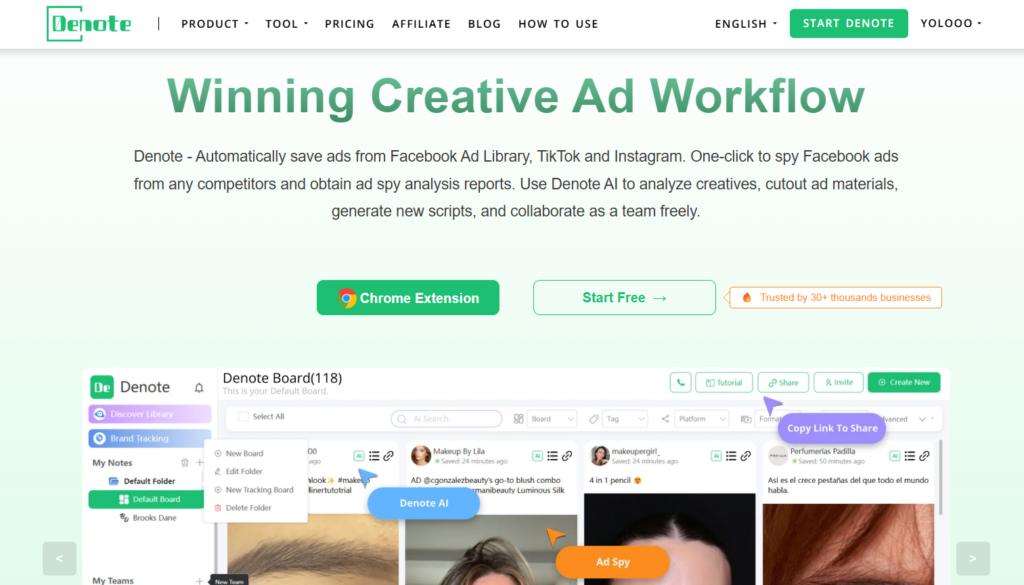
How to use it:
- Feed Denote (or similar tools) your top-performing creatives to get attribute-level insights.
- Use the output to generate hypotheses for new creatives and prioritize tests.
- Combine Denote’s analysis with your user data to align creative to audience segments.
I recommend integrating creative intelligence tools into your workflow — they speed up the “find what works” stage when you scale Facebook ads.
(Denote mentioned again below with a practical tip.)
Automated Bidding and Performance Prediction
Modern platforms offer machine learning-driven bidding that can predict conversions and optimize bids in real time. Use these tools to maintain efficiency as scale increases. Pair predictive bidding with rigorous validation: run holdouts or incrementality tests to verify performance lift.
AI-Based Ad Copy and Image Optimization
AI can generate variant headlines, CTAs, and image crops at scale. Treat AI outputs as drafts: human polish is still essential. When you want to scale Facebook ads quickly, AI can produce dozens of creative permutations so you can rapidly iterate and find winners.
A workflow:
- Generate 20 copy variants with AI.
- Pair each with 3 image treatments.
- Run a structured test and let winners graduate into scaled campaigns.
And again, combine creative intelligence (e.g., Denote insights) with AI generation to keep your output strategic rather than random.
(Third mention of Denote for SEO balance and context: Denote helps you spot category-level creative trends so your AI-generated variations start from a smarter baseline.)
Common Mistakes When Scaling Facebook Ads
Scaling is seductive. It promises volume and growth — but the wrong moves turn profit into cost. Here are mistakes I’ve seen teams make again and again.
Scaling Too Fast Without Data
Throwing budget at an unvalidated creative will amplify losses. If an ad hasn’t proven lift across multiple audiences and metrics, don’t scale it. Think of validation as a hygiene check before heavy lifting.
Ignoring Ad Fatigue
Ad fatigue is real and quick. If engagement falls and CPC rises, refresh creative or rotate audiences. Ignoring fatigue means watching your CPA climb while you scratch your head.
Neglecting Retargeting Campaigns
Many brands pour everything into prospecting and forget retargeting. A robust retargeting funnel multiplies the ROI of scaled prospecting spend — don’t neglect it.
Advanced Scaling Tactics for 2025
If you’ve got the basics humming, these advanced tactics help you punch through the next growth ceiling.
Use Lookalike Audiences 2.0
Still killer, but don’t just spray and pray. Seed those audiences with your A-listers—folks who actually spend money, stick around, or, I dunno, show up more than three times without ghosting you. Layer lookalikes, toss in some interest exclusions, and you’ll cut the overlap junk that eats your budget for breakfast.
Combine Facebook + TikTok Data
Mash up the data. Something pops on TikTok? Steal that energy and drop it into your Facebook tests. See which hooks or audiences are crushing it, then cross-pollinate. Plus, TikTok’s a playground for wild creative ideas. If it takes off there, odds are you can crank it up on Facebook too.
Test Dynamic Creative Ads (DCA)
Feed it solid headlines, images, CTAs, and let the algorithm cook. But watch it, because garbage in = garbage out. Don’t just throw in every asset you’ve got—curate, then babysit the combos so you don’t end up with some Frankenstein ad disaster.
When to Switch to Advantage+ Campaigns
Advantage+ and similar automated campaign types are useful when you want aggressive automation and have clean, consistent conversion data. Switch when you’ve validated creatives and audiences — and use holdouts to measure incremental lift.
Conclusion
If you want to scale Facebook ads in 2025, think like a builder and a scientist. Create solid foundations, validate relentlessly, and use technology (AI tools and platforms like Denote) to accelerate learning — not to replace judgment. Scale slowly, measure precisely, and let winning creatives and audiences compound over time. Do this, and your scaled campaigns will feel less like a gamble and more like a predictable engine of growth.
